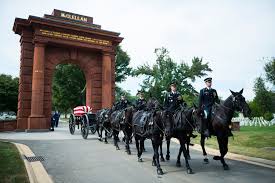Justice Ginsburg to be buried at Arlington National Cemetery

The entrance to Arlington National Cemetery
Late last week when Supreme Court Justice Ruth Bader Ginsburg’s body was being removed from Statutory Hall at the United States Capitol I heard that her body would be interred this week at Arlington National Cemetery. As a person who loves the history, majesty, and ceremony that is Arlington National Cemetery, I wondered a little about the eligibility criteria for such a burial.
Turns out, according to this article, membership on the United States Supreme Court, even with no military history, satisfies the eligibility requirement of Arlington National Cemetery by itself. As a matter of fact, the article states that thirteen other Supreme Court justices are buried at Arlington.
It is expected that Justice Ginsburg will be buried next to her husband, an Army veteran who died in 2010. The last Supreme Court justice to be buried among the 400,000 or so military veterans was John Paul Stevens who died in 2019.
Interestingly enough, former President William Howard Taft satisfied eligibility requirements by being both a President of the United States and a Supreme Court justice. An interesting thing about President Taft, that you would probably not see today, is that he was nominated, approved, and served on the Supreme Court after his one term as President.
The only other President that is buried at Arlington National Cemetery is President John F. Kennedy who died in 1963.
Funeral Director Daily take: I love the history of Arlington National Cemetery and as someone who worked for 35 years in the death care profession, I understand the solemnity and reverence that the grounds carry. While some of you may like Disney World and those kind of places, my favorite spot for a long weekend is Washington, DC.
On a beautiful day I love to stroll around the Arlington grounds, the National Mall grounds, and go into the government operated museums that are free of charge to all of us citizens. Maybe I’m a little different, but to me there is nothing so valuable as seeing the sacrifices that were made by so many to build this nation.
Arlington House – Doing the research on the Justice Ginsburg burial reminded me of a couple of items about Arlington National Cemetery that maybe not every body knows. One item is that the ownership of the property that the cemetery sits on was once in the family of George Washington and eventually became the property of Gen. Robert E. Lee, best known for his role in the Army of the Confederacy.
Here’s a little of the story from Wikipedia where you can find more information.

Arlington House overlooking Arlington National Cemetery
The house that sits at Arlington, Arlington House (of which I’ve been in), was built in 1802 by George Washington Parke Custis, a grandson of George Washington, whose father, John Parke Custis had purchased the property in 1778. Arlington House was being built by the grandson to serve as a memorial to George Washington and is designed similar to Washington’s own house at Mount Vernon.
We will skip some things here you can read on your own, but George Washington Parke Custis had only one surviving child and in 1831 she married a young West Point soldier named Robert E. Lee. Lee was eventually appointed an officer in the United States Army and he and his wife, Mary Anna Custis Lee, lived between duty stations and Arlington House. In 1857 they inherited the house completely upon the death of Mrs. Lee’s father, George Washington Parke Custis.
Then, in 1861, the state of Virginia succeeded from the Union to join the South in Civil War. Three weeks later, General Lee resigned his U.S. Army commission to join the Confederate Army.
Arlington House was built on high ground overlooking Washington, DC, and had strategic battle value to whomever held it. As was done with a lot of Southern property, the property was seized for failure to pay taxes to the Union. And, by 1864, the Union was looking for places to bury the vast amount of deceased soldiers. United States Secretary of War, Edwin Stanton approved the establishment of the grounds as a military cemetery on June 15, 1864. That established Arlington National Cemetery.
Following the Civil War, General Robert E. Lee made no attempt to visit or restore his title to Arlington House or the property. However, in 1874, his son filed suit to regain the property in a Virginia court. The case went all the way to the U.S. Supreme Court and in 1882 the court ruled in favor of Lee on a 5-4 vote saying the home and property had been “illegally confiscated”. One year later, Lee and the federal government reached an agreement for fair value at $150,000 (which would be $4.4 million in 2019 dollars). Congress approved the settlement and a title transfer was recorded on May 14, 1883.
This topic today could be entitled “What goes around comes around” as we started with a Supreme Court justice and where she is to be buried and we ended with a note on how the Supreme Court played a role in actually establishing the cemetery.
Tomorrow I will bring you another interesting story about a United States soldier who was given special permission from President Ronald Reagan to be buried in Arlington National Cemetery regardless of the requirements listed.





















Isn’t it amazing that anyone else takes 5-6 months to get a spot but not her……Not saying she is not deserving but why does she get head of the line……
Great piece. I lived in DC for 2 yers 15 years ago…it was my first place to live in the US, I adore it there. a second home 🙂
Great research and storytelling Tom.
History is indeed both interesting and fun !
Keep up the good work.